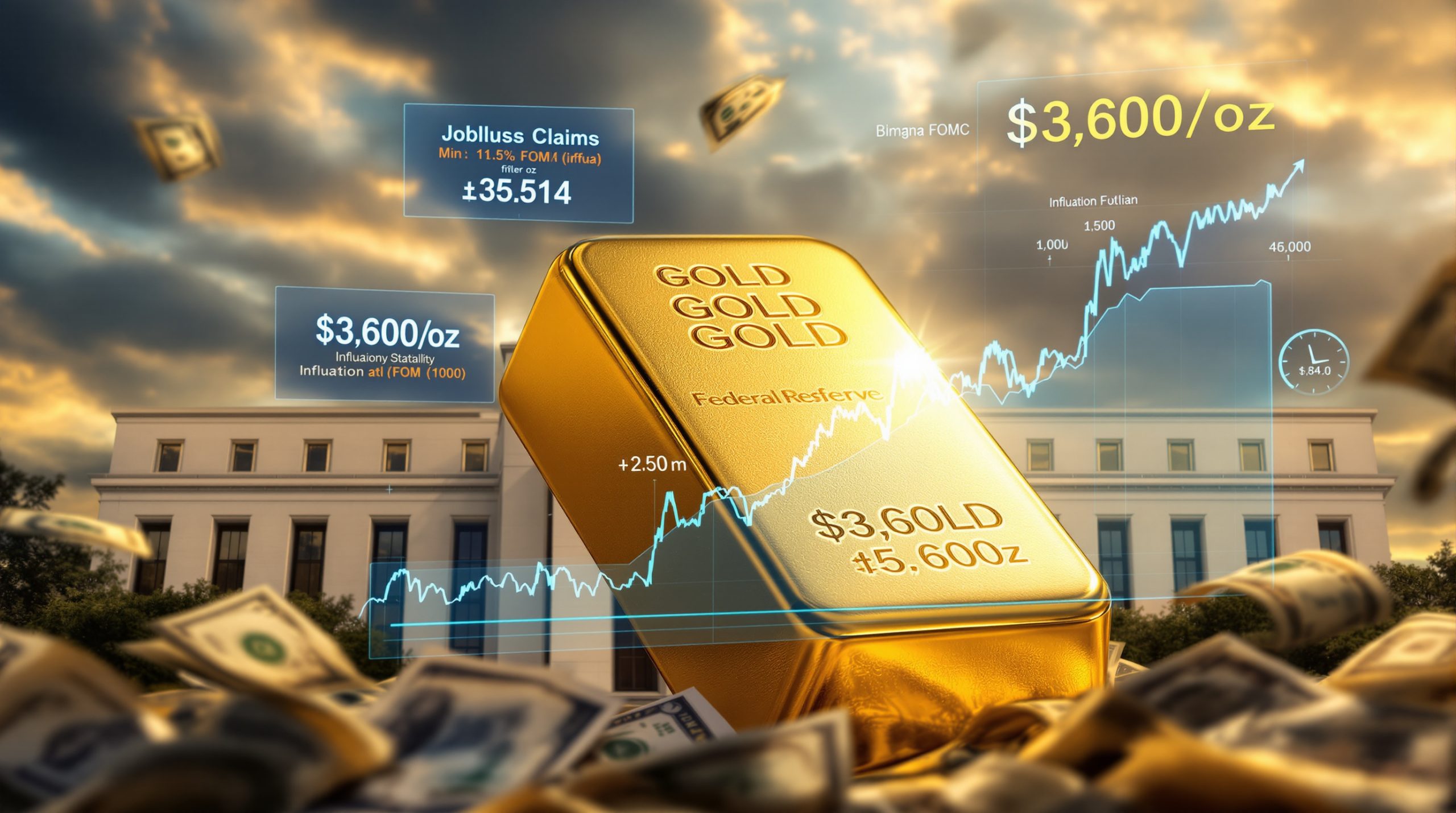Gold Holds Steady Despite Rate Cut Buzz and Jobless Spike
Gold prices have maintained remarkable stability around significant price levels despite growing expectations for Federal Reserve interest rate cuts and concerning labor market signals. This gold price analysis demonstrates the complex interplay of economic factors currently influencing precious metals markets as investors position themselves ahead of a potentially pivotal FOMC meeting.
Gold's Recent Price Performance
Gold has traded within a controlled band following Monday's breakout to new highs, with prices remaining well-supported throughout the trading week. Current levels represent historically significant valuations when compared to previous market cycles. The precious metal has shown impressive year-to-date performance, demonstrating its continued appeal as both a safe haven asset and record high inflation hedge.
The relatively flat intraday charts following the initial breakout suggest a period of consolidation rather than weakness—a potentially bullish sign indicating price stability at elevated levels.
What Economic Signals Are Driving Gold Market Sentiment?
Inflation Data Points to Rate Cut Possibilities
The August Consumer Price Index (CPI) report released Thursday provided crucial insights into current inflation trends. Core inflation (excluding food and energy) printed at 3.1% year-over-year, matching projections, while overall inflation registered at 2.9% annually, remaining below the psychologically important 3% threshold.
Monthly inflation came in slightly hotter than expected at 0.4% versus 0.3% forecasts, but underlying data suggests inflation pressures remain generally subdued. According to official data from the Bureau of Labor Statistics, most categories showed moderate price increases, with shelter costs continuing to be a significant contributor.
This inflation picture keeps the door wide open for the Federal Reserve to initiate interest rate cuts at their upcoming September meeting, a scenario that traditionally supports gold prices.
Labor Market Developments Create Additional Pressure
Thursday's jobless claims report delivered an unexpected shock to markets with applications for unemployment benefits jumping by more than 25,000 entries to reach the highest level in nearly four years. This dramatic increase surprised economists who had expected the number to remain relatively flat from the previous week.
This jobless claims spike doesn't stand alone in suggesting labor market weakness:
- Private ADP Payrolls have shown consistent weakness in recent reports
- JOLTS Job Openings have been declining for several consecutive months
- ISM Employment Indexes remain in contraction territory
- Wage growth has moderated from previous highs
This combination of labor market signals adds significant pressure on the Federal Reserve to begin easing monetary policy, potentially accelerating rate cut timelines beyond what was previously expected.
Why Hasn't Gold Surged Higher Given These Tailwinds?
Despite economic indicators strongly pointing toward imminent rate cuts—traditionally a powerful catalyst for gold prices—the precious metal hasn't experienced a dramatic surge. Several factors may explain this measured response:
Market Expectations Already Priced In
Gold's substantial year-to-date gains suggest that considerable rate cut expectations have already been incorporated into current prices. The market has been anticipating Fed easing for months, with gold steadily climbing in anticipation.
Financial futures markets have been pricing in multiple rate cuts for the remainder of the year, meaning Thursday's data may have simply confirmed what investors already believed, rather than representing new information that would drive prices significantly higher.
Questions About Fed's Forward Guidance
Investors remain uncertain about the Fed's longer-term plans. Will the Fed deliver a single cut without clear forward guidance? How aggressive will the easing cycle be? Will communication focus on data dependency or signal a predetermined path?
These uncertainties may be tempering additional upside momentum as traders await concrete policy signals from the upcoming FOMC meeting. The magnitude of any potential gold rally could depend significantly on how clearly the Fed articulates its future intentions.
Technical Consolidation Phase
After significant gains earlier in the year, gold may be experiencing a natural consolidation phase where prices digest recent moves before determining the next directional trend. This pattern is common after strong breakouts, as markets often need time to establish new support levels before continuing higher.
Technical analysts note that this consolidation is occurring at historically high levels, suggesting underlying strength rather than exhaustion in the current bull trend.
What Are The Potential Scenarios After The Fed Meeting?
The upcoming Federal Reserve meeting represents a critical inflection point for gold market performance. Several scenarios could unfold:
Scenario 1: Fed Cuts With Strong Forward Guidance
If the Fed delivers the expected rate cut while clearly communicating plans for additional easing, gold could break out above current levels. Markets would likely interpret this as confirmation of a prolonged easing cycle, potentially triggering new investment flows into precious metals.
Traders would closely monitor the dot plot projections and language in the policy statement for clues about the pace and extent of future cuts.
Scenario 2: Single Cut With Ambiguous Guidance
A rate cut without clear forward guidance might lead to temporary disappointment and volatility in gold markets, as traders reassess how much of gold's recent performance was predicated on expectations of a sustained easing cycle.
This scenario could create a "buy the rumor, sell the fact" dynamic where gold experiences short-term pressure despite the actual implementation of a rate cut.
Scenario 3: More Aggressive Easing
Given the surprising jobless claims data, the Fed could potentially implement a larger cut. This scenario would likely trigger a significant gold rally as markets interpret such a move as signaling serious concern about economic conditions.
An aggressive cut would also likely weaken the U.S. dollar, providing additional support for dollar-denominated gold prices.
How Does Gold Compare To Other Assets In This Environment?
Gold's stability comes against a backdrop of interesting market dynamics across other asset classes:
- Equities: U.S. stock markets have continued pushing toward new all-time highs as investors anticipate rate cuts
- Treasury Yields: Have been trending lower, reducing the opportunity cost of holding non-yielding assets like gold
- U.S. Dollar: Has shown weakness against major currencies, providing additional support for dollar-denominated gold prices
This intermarket analysis suggests gold remains well-positioned even as investors simultaneously embrace risk assets, reflecting complex cross-currents in the current economic environment.
The historical negative correlation between gold and real interest rates continues to influence market dynamics, with lower anticipated rates supporting the case for precious metals allocation.
What Technical Factors Are Influencing Gold Prices?
From a technical perspective, several important levels and patterns are worth monitoring:
Key Support and Resistance Levels
- Strong Support: Established around recent lows, representing a psychological floor
- Immediate Resistance: The recent high near Monday's breakout level
- Major Resistance: Historical and psychological barriers at higher levels
Technical analysts note that gold's trading pattern has maintained higher lows throughout recent consolidation, suggesting underlying strength. The formation of a potential bull flag pattern on the daily chart could indicate further upside potential following this consolidation phase.
Trading Pattern Analysis
Volume profiles during recent trading sessions have shown stronger participation during upward moves compared to downward corrections, suggesting that buyers remain in control of the overall trend despite short-term price swings.
Momentum indicators like the Relative Strength Index (RSI) have moved down from overbought territory, potentially setting up healthier conditions for sustainable future gains.
What Are The Long-Term Forecasts For Gold?
Looking beyond the immediate Fed decision, several compelling gold price forecasts have emerged:
- Potential for higher prices by year-end if Fed easing proceeds as expected
- Forecasts ranging higher in subsequent years if monetary easing continues alongside persistent geopolitical uncertainties
- Growing recognition of gold's role as a portfolio stabilizer in an environment of economic transition
These projections reflect gold's traditional appeal during periods of monetary policy shifts and economic uncertainty. Analysts point to ongoing central bank gold purchases, particularly from emerging market countries, as providing additional long-term support for prices.
What Should Investors Watch For Next Week?
As markets approach the critical Fed meeting, several key factors will influence gold's next directional move:
Fed Communication Strategy
The specific language used in the FOMC statement and Chair's press conference will be scrutinized for clues about the pace and extent of future rate cuts. Markets will analyze every word choice for hints about whether this is the beginning of a sustained easing cycle or a more cautious, data-dependent approach.
Market Reaction Analysis
How other assets respond to the Fed decision—particularly Treasury yields and the U.S. dollar—will provide important context for gold's post-meeting performance. The correlation between these markets often provides valuable insight into the underlying forces driving price action.
Technical Breakout Potential
Traders should monitor whether gold can decisively break above its recent trading range following the Fed announcement, which would signal potential for further upside. A close above recent highs with strong volume would be particularly significant from a technical perspective.
How Should Investors Approach Gold In The Current Environment?
Given the complex interplay of factors influencing gold prices, investors might consider several strategic approaches:
For Long-Term Investors
- Maintain strategic allocations to gold as a portfolio diversifier and potential inflation hedge
- Consider dollar-cost averaging to manage entry points during this period of consolidation
- Focus on physical gold or low-cost ETFs for efficient exposure
Long-term investors should view current market conditions through the lens of broader economic cycles and gold's historical performance during periods of monetary easing.
For Active Traders
- Prepare for potential volatility surrounding the Fed meeting
- Consider options strategies to capitalize on possible price swings
- Monitor key technical levels for breakout or breakdown signals
Active traders should be particularly attentive to intraday price action and volume patterns around key economic announcements and the Fed decision.
FAQ: Gold Price Dynamics and Federal Reserve Policy
Why does gold typically rise when interest rates fall?
Gold produces no yield, so when interest rates decline, the opportunity cost of holding non-yielding assets decreases. Additionally, lower rates often lead to currency depreciation and inflation concerns, both supportive factors for gold prices.
Lower interest rates also tend to increase the present value of future cash flows from all assets, which can drive investment demand across various markets, including precious metals.
How significant is the jobless claims spike for Fed policy?
The dramatic increase in weekly jobless claims represents a potential early warning signal about labor market deterioration. If confirmed by additional data, this could accelerate the Fed's easing cycle, potentially supporting gold prices.
Historically, the Fed has responded quickly to signs of labor market weakness, as employment represents one half of their dual mandate alongside price stability.
Could gold prices decline after a rate cut announcement?
Yes, through a "buy the rumor, sell the fact" dynamic. If the actual Fed policy announcement falls short of market expectations regarding future cuts, gold could experience temporary weakness despite the initial rate reduction.
This pattern has occurred in previous rate cut cycles, where markets had already priced in policy changes before they were officially implemented.
How does gold's current price compare historically?
Current gold prices represent historic price milestones and exceed inflation-adjusted prices from previous bull markets, including the 1980 peak and earlier valuations.
When analyzing gold's price trajectory, investors should consider both nominal price movements and inflation-adjusted values to gain perspective on where prices stand relative to historical cycles.
Further Exploration
Readers interested in learning more about gold price dynamics and monetary policy can also explore related educational content on precious metals markets and Federal Reserve policy impacts. Understanding the relationship between interest rates, inflation expectations, and gold prices provides valuable context for navigating current market conditions.
Monitoring central bank gold purchases, ETF flows, and physical demand from key markets like India and China can provide additional insights into the fundamental drivers of gold prices beyond monetary policy considerations. As geopolitical tensions continue to shape markets, gold holds steady despite rate cut buzz and jobless spike, maintaining its historical role as a refuge during uncertain times.
Want to Capitalise on the Next Major Mineral Discovery?
Get instant alerts on significant ASX mineral discoveries through Discovery Alert's proprietary Discovery IQ model, turning complex exploration data into actionable investment insights. Understand why historic discoveries can generate substantial returns by visiting Discovery Alert's dedicated discoveries page and begin your 30-day free trial today.




